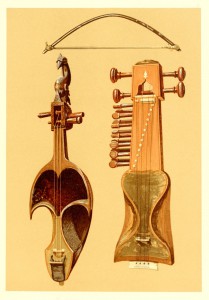THE Sarangi, or fiddle of India, shown to the right of this plate,
is usually strung with three strings of thick gut and played with
a bow. Sometimes a fourth string of wire called Inntj is added.
The fingers of the left hand, in stopping the strings, do not press them
down upon the finger-board, but press against them at the side in all the
positions. The tone of the sarangi more nearly resembles that of the viola
than any European instrument, and when well played there is a charm about
the instrument that is not easily forgotten. The sarangi is frequently employed
tt) plav a sort of obbligato to a song, particularly in theatrical performances and
by Nautch companies. There are generally in instruments of this kind fifteen
sympathetic strings of wire tuned chromaticall}‘. The instrument is made from
a single block of wood hollowed out, and has a parchment belly. When in use
it is held vertically, head uppermost. Curiously enough, as was the case with the
violin in England at one time, the instrument is considered to be rather vulgar,
and hence musicians, though thev admire and like it much, will usually employ
either a low caste Hindu or a Mussulman to play it.
The three-stringed instrument to the left of the plate is the Sarinda, a bowed
instrument common in Bengal. The decoration and carving are characteristic,
although rough. The Sarinda is not a very high-class instrument, but is very
popular with the lower classes. The tuning is like that of the chikara, and the
strings are of cut or silk. The bow used with it is that shown. The chief
peculiaritv of the Sarinda consists in the way that the belly, which is of
parchment, is put on. As will be seen by the plate, it is made to cover only the
lower part of the body, leaving the upper half quite open.

